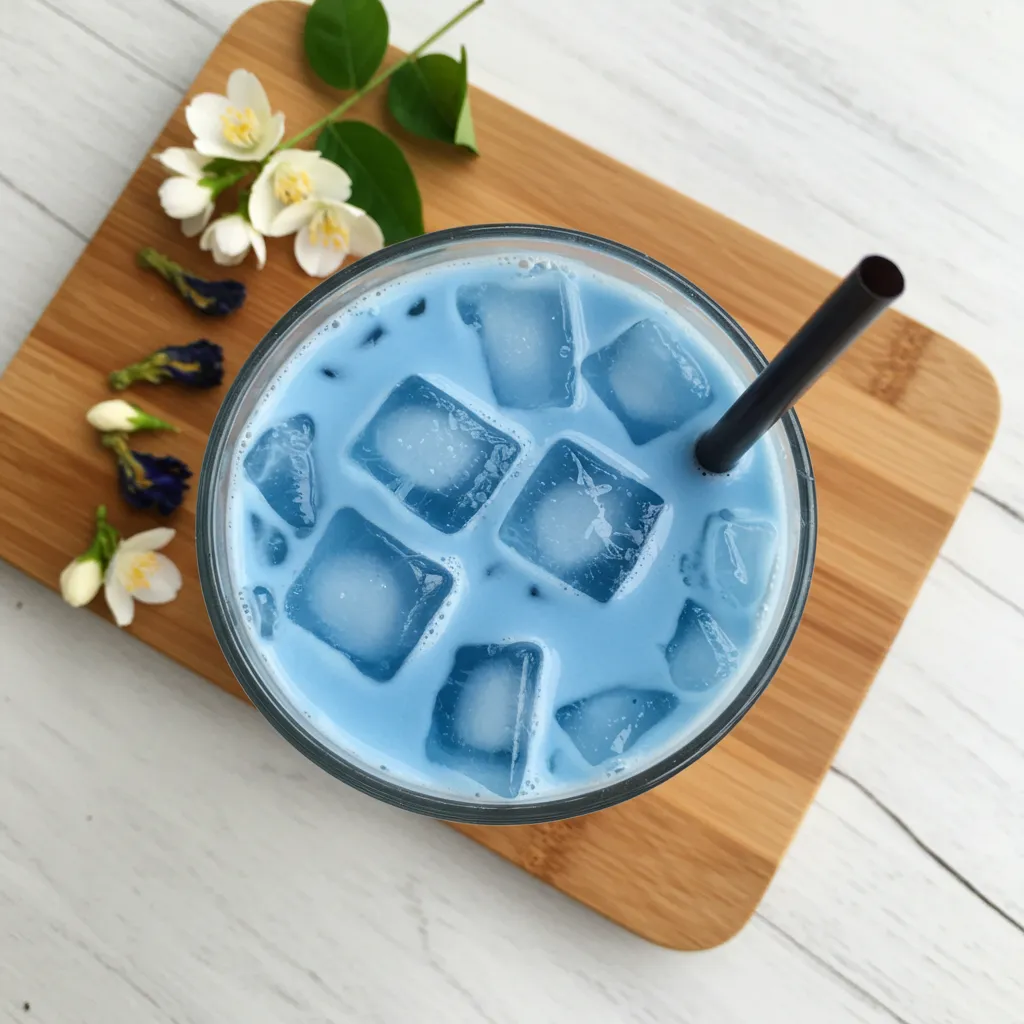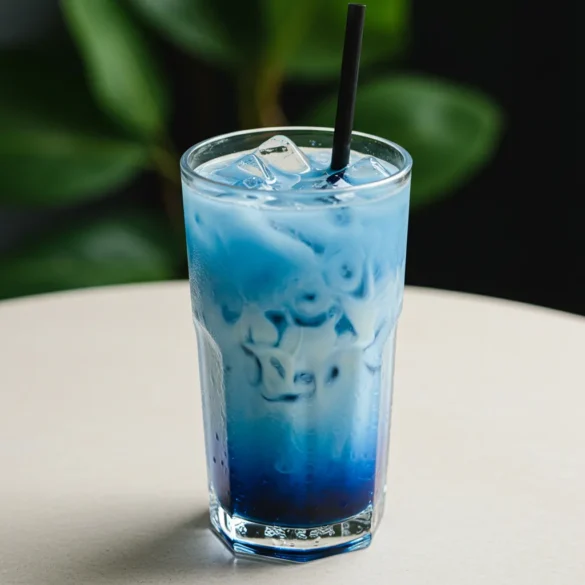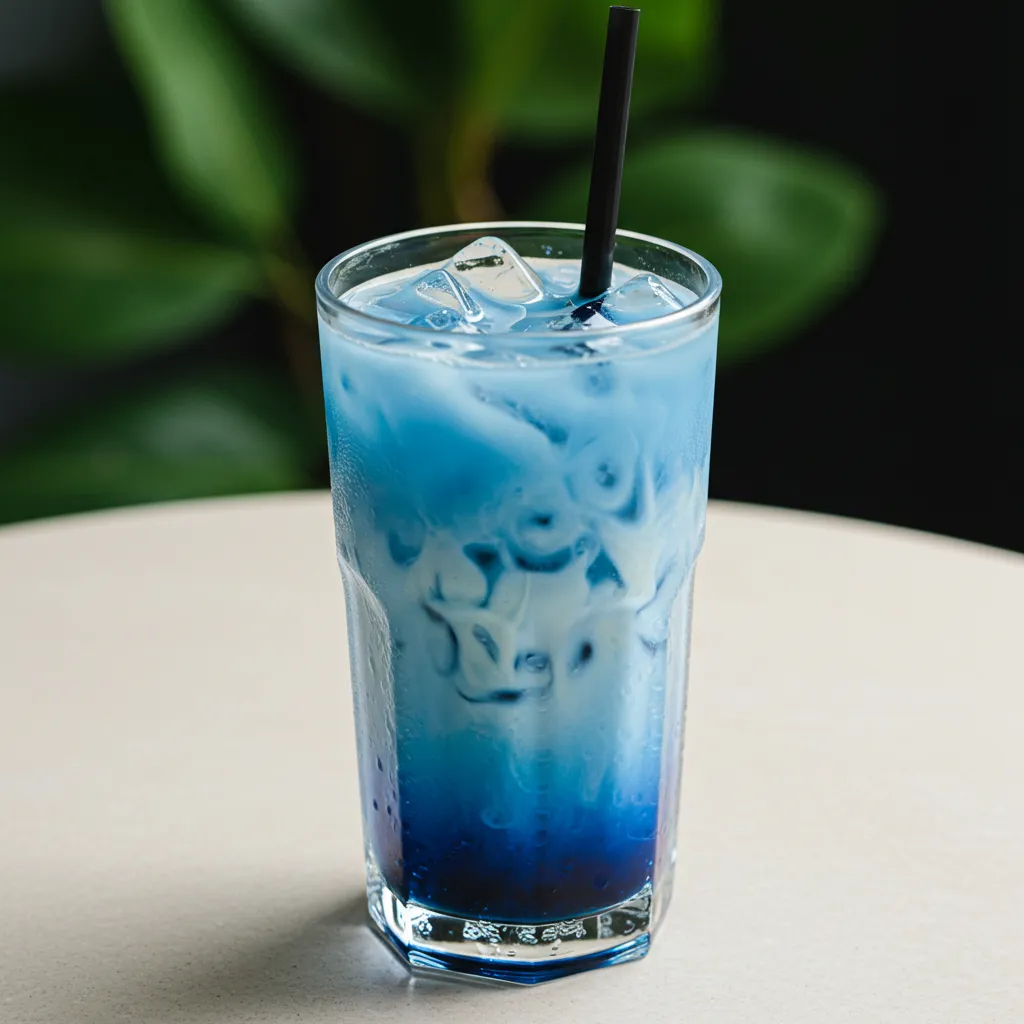This stunning Blue Milk Tea combines the floral notes of butterfly pea flower and jasmine tea with the creamy richness of milk and condensed milk, creating a drink that’s as beautiful as it is delicious. The natural color-changing properties of butterfly pea flower tea give this beverage its mesmerizing blue hue without any artificial coloring. Perfect for Instagram-worthy refreshment or a unique addition to your tea rotation, this easy-to-make drink will surely impress both your taste buds and your guests.
Why You’ll Love This Recipe
- Naturally colorful: The vibrant blue comes from butterfly pea flowers, not artificial dyes
- Customizable sweetness: Adjust the condensed milk to your preference
- Simple preparation: Basic ingredients and straightforward steps
- Visually stunning: Creates a beautiful drink that’s perfect for photos
- Unique flavor profile: Floral jasmine with subtle butterfly pea notes
- Color-changing potential: Add lemon for a purple transformation
Ingredients
For the Tea Base
- Dried butterfly pea flowers – Provide the signature blue color and subtle earthy flavor
- Jasmine tea – Adds floral aromatic notes that complement the butterfly pea
- Water – The brewing medium for extracting flavors and color
For the Milk Component
- Milk – Creates the creamy base (whole milk recommended for richness)
- Sweetened condensed milk – Adds sweetness and velvety texture
- Ice cubes – Chill the drink while maintaining the beautiful color
Optional Additions
- Vanilla extract – Enhances the creamy flavor profile
- Lemon or lime juice – Creates a magical color change from blue to purple
- Boba pearls – Adds a chewy texture element for a bubble tea variation
- Simple syrup – For additional sweetness if desired
Step-by-Step Instructions
Brewing the Blue Tea Base
Begin by preparing the butterfly pea flower tea, which will provide the striking blue color that makes this drink so special. In a small pot, bring 2 cups of filtered water to just below boiling (around 185°F/85°C). Using water that’s too hot can make the tea bitter and affect the vibrant color.
Add 2 tablespoons of dried butterfly pea flowers to the hot water. If you’re using butterfly pea flower tea bags, use 2-3 tea bags instead. Let the flowers steep for 3-4 minutes, watching as the water transforms into a deep indigo blue. The steeping time is important – too short and the color won’t fully develop, too long and the tea can become astringent.
While the butterfly pea flowers are steeping, prepare the jasmine tea in a separate pot. Heat 1 cup of water to about 175°F/80°C and add 2 teaspoons of loose jasmine tea or 2 jasmine tea bags. Steep for 2-3 minutes, then remove the tea leaves or bags to prevent bitterness. Jasmine tea adds a beautiful floral aroma and flavor that balances the earthier notes of the butterfly pea flowers.
Strain both teas through a fine-mesh sieve into a heatproof container, combining them to create your blue tea base. The resulting mixture should be a clear, vibrant blue color. Allow the tea to cool to room temperature before proceeding to the next step. You can expedite this process by placing the container in an ice bath if you’re short on time.
Creating the Milk Mixture
In a small bowl or measuring cup, combine 1 cup of cold milk with 2-3 tablespoons of sweetened condensed milk, adjusting the amount based on your desired sweetness level. Whole milk creates the richest taste and mouthfeel, but you can substitute 2% milk, oat milk, or almond milk based on your preference or dietary needs. Whisk until the condensed milk is completely dissolved and the mixture is smooth.
If using vanilla extract, add 1/4 teaspoon now and stir to incorporate. The vanilla isn’t traditional but adds another dimension of flavor that complements both the jasmine and the milk beautifully. This step is optional but recommended for a more nuanced flavor profile.
Assembling the Blue Milk Tea
Fill two tall glasses about halfway with ice cubes. The ice not only chills the drink but also helps create the layered effect that makes this drink visually appealing. For best results, use clear glasses to showcase the beautiful blue color.
Slowly pour the cooled blue tea mixture over the ice, filling each glass about 2/3 full. The tea should begin to chill immediately upon contact with the ice, creating a beautiful cascade of blue through the glass.
Next comes the transformative step – carefully pour the milk mixture over the back of a spoon held just above the surface of the tea. This technique allows the milk to float on top of the blue tea rather than mixing immediately, creating a striking layered effect with blue tea on the bottom and white milk on top. The layers will gradually integrate as the drink sits or when stirred.
For presentation, add a straw and perhaps a jasmine flower or butterfly pea flower as a garnish if available. The contrast of the delicate flower against the blue drink creates an especially photogenic beverage.
Serving and Enjoying
Before drinking, stir the blue milk tea to fully integrate the milk with the tea. Watch as the blue color transforms into a pastel blue shade throughout the drink. The first sip offers a delightful combination of floral jasmine notes, the subtle earthiness of butterfly pea, and creamy sweetness from the milk and condensed milk.
For an interactive element that’s sure to impress guests, serve the drink layered and provide a small dish of lemon or lime juice on the side. When added to the blue milk tea, the citrus causes a chemical reaction with the butterfly pea flower’s natural pigments, transforming the blue to a vibrant purple before your eyes.
This blue milk tea is best enjoyed fresh, as the colors are most vibrant and the flavors most balanced immediately after preparation. Serve cold as a refreshing afternoon treat or alongside light desserts.

Pro Tips
- Use filtered water for the clearest color and best flavor
- For a more intense blue, increase the amount of butterfly pea flowers
- Chill glasses in the freezer before serving for an extra-refreshing drink
- If butterfly pea flowers aren’t available whole, tea bags work just as well
- For a smoother transition between layers, pour the milk over a spoon
Variations and Creative Ideas
The versatility of this blue milk tea recipe allows for numerous delicious variations:
Alternative Tea Bases
Butterfly Pea Flower and Earl Grey: Substitute jasmine tea with Earl Grey for a bergamot-infused twist that pairs beautifully with the butterfly pea flower. The citrus notes of Earl Grey add complexity while maintaining the stunning blue color.
Lavender Blue Milk Tea: Add a teaspoon of dried culinary lavender to the butterfly pea flowers during steeping. The lavender contributes additional floral notes that complement the natural florality of both jasmine and butterfly pea flowers.
Butterfly Pea Flower and Green Tea: For a lighter, more vegetal flavor profile, use green tea instead of jasmine. This creates a refreshing alternative with subtle grassiness that balances the creaminess of the milk.
Sweetener Alternatives
Honey Sweetened: Replace the condensed milk with a combination of regular milk and honey for a different type of sweetness with floral undertones that enhance the jasmine tea.
Brown Sugar Syrup: Create a rich brown sugar syrup (1:1 ratio of brown sugar to water, simmered until dissolved) to sweeten your milk tea instead of condensed milk. This adds caramel notes that contrast beautifully with the floral tea base.
Coconut Sugar: Use coconut sugar simple syrup for a more complex sweetness with tropical undertones that pair well with the butterfly pea flower’s exotic nature.
Milk Variations
Coconut Milk Blue Tea: Substitute regular milk with coconut milk for a tropical twist that complements the floral notes perfectly. The slight coconut flavor adds another dimension to the drink.
Oat Milk Blue Tea: For a dairy-free version with excellent creaminess, use barista-style oat milk, which froths well and has a neutral flavor that allows the tea notes to shine through.
Almond Milk Variation: Almond milk creates a lighter version with subtle nutty undertones that pair surprisingly well with butterfly pea and jasmine flavors.
Special Additions
Blue Milk Tea with Boba: Cook tapioca pearls according to package directions and add to the bottom of the glass before pouring in the blue tea and milk for a bubble tea variation.
Blue Milk Tea Latte (Hot Version): For cooler weather, serve this as a hot latte by heating the milk mixture and adding it to the hot blue tea base. Skip the ice and instead serve in a clear mug to showcase the color.
Blue Milk Tea Float: Add a scoop of vanilla ice cream on top instead of the milk layer for a dessert-like treat that’s both visually stunning and deliciously indulgent.
Storage and Make-Ahead Advice
While Blue Milk Tea is best enjoyed fresh for optimal color and flavor, there are several ways to prepare components in advance:
Tea Base Preparation: The butterfly pea and jasmine tea mixture can be brewed and refrigerated for up to 48 hours in an airtight container. This makes assembly quick when you’re ready to serve, and the cold tea base helps maintain the layered effect when milk is added.
Batching for Events: For parties, prepare a large batch of the blue tea base and store it in a pitcher in the refrigerator. Keep the milk mixture in a separate container. When ready to serve, set up a station where guests can pour their own layers or assemble drinks individually.
Not Recommended: Pre-mixing the complete drink with milk for storage, as separation will occur and the vibrant color may diminish over time. Additionally, the ice will melt and dilute the flavors if stored too long.
For the best visual impact and taste experience, assemble individual drinks no more than 10-15 minutes before serving, or set up a self-service station with clear instructions for guests to create their own layered blue milk tea.
The Science Behind the Blue Color
The magical blue color of this tea comes from a natural pigment called anthocyanin found in butterfly pea flowers. This compound is pH-sensitive, which is why adding acidic ingredients like lemon juice transforms the color from blue to purple or pink.
This natural color-changing property has made butterfly pea flower tea increasingly popular in modern mixology and tea culture. In traditional Southeast Asian cultures, particularly in Thailand and Malaysia, butterfly pea flower tea has been consumed for centuries for both its beautiful color and purported health benefits.
When combined with milk, the vibrant blue becomes a softer, pastel shade due to light scattering through the milk’s fat particles – a phenomenon called the Tyndall effect. This creates the gentle, cloudy blue that makes this drink so visually appealing.
Frequently Asked Questions
Where can I find butterfly pea flowers? Dried butterfly pea flowers are available at many Asian grocery stores, specialty tea shops, health food stores, or online retailers. They’re becoming increasingly popular, so availability has improved significantly in recent years.
Is the blue color natural or from food coloring? The blue color is completely natural, derived solely from the butterfly pea flowers. No artificial coloring is needed or used in this recipe.
Can I make this without jasmine tea? Yes! While jasmine tea adds a lovely floral note, you can substitute with plain green tea, white tea, or even skip the second tea altogether for a pure butterfly pea flower flavor.
Will this work with non-dairy milk? Absolutely. Oat milk, almond milk, soy milk, or coconut milk all work well. For the best creamy texture, choose barista versions of these plant-based milks when available.
How can I make this less sweet? Simply reduce the amount of condensed milk or substitute it with a small amount of simple syrup or honey to control the sweetness level precisely to your taste.

Ingredients
- 2 tablespoons dried butterfly pea flowers (or 2-3 tea bags)
- 2 teaspoons loose jasmine tea (or 2 tea bags)
- 3 cups water, divided
- 1 cup milk (whole milk recommended)
- 2-3 tablespoons sweetened condensed milk, to taste
- 1/4 teaspoon vanilla extract (optional)
- Ice cubes
- Lemon or lime wedges (optional, for color-changing effect)
Instructions
- Bring 2 cups of water to just below boiling (185°F/85°C). Add butterfly pea flowers and steep for 3-4 minutes until the water turns deep blue.
- In a separate pot, heat 1 cup of water to 175°F/80°C. Add jasmine tea and steep for 2-3 minutes.
- Strain both teas and combine them in a heatproof container. Allow to cool to room temperature.
- In a small bowl, mix milk with condensed milk and vanilla extract (if using) until fully combined.
- Fill two tall glasses halfway with ice cubes.
- Pour the cooled blue tea over the ice, filling each glass about 2/3 full.
- Slowly pour the milk mixture over the back of a spoon to create a layered effect.
- Serve with a straw and optional lemon wedge on the side.
- Stir before drinking to fully combine the flavors.
Notes
- The ratio of butterfly pea tea to jasmine tea can be adjusted based on your preference for color intensity and flavor
- If you can't find butterfly pea flowers, look for butterfly pea powder as an alternative
- For the most vibrant blue color, use fresh, high-quality butterfly pea flowers
- Test the sweetness after adding 2 tablespoons of condensed milk before adding more
- For the most impressive layered effect, make sure both the tea and the milk are well-chilled

